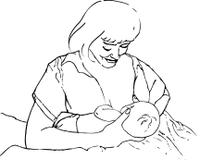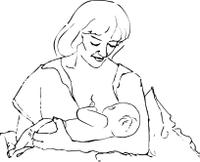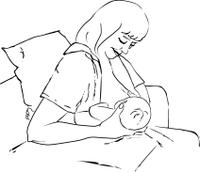You will be encouraged to breastfeed soon after the birth of your baby. Some babies may breastfeed right away, while others may want to be cuddled at the breast. Cuddling is also an important step to breastfeeding. Early skin-to-skin contact can help you recognize your baby’s feeding cues. Babies communicate verbally and non-verbally.
Feeding cues
Breastfeed your baby when you notice the following signs of hunger:
- Lip smacking
- Hand to mouth movements
- Sucking on hands
- Rooting
- Crying – the last feeding cue. You may need to calm your baby before breastfeeding if he or she is crying. Try to breastfeed your baby before he or she starts to cry.
When your baby is satisfied, he or she will:
- Come off the breast spontaneously or fall asleep at the breast.
- Be awake with no further feeding cues
- Turn away from an alternate feeding method (for example, bottle, cup, spoon, syringe) or push it out of his or her mouth
Getting comfortable
- Calm your baby if she or he is crying. Babies feed best when they are quiet and alert. Unwrap your baby
- Your comfort is important. Sit up as straight and “tall” as possible. Lengthen your spine. Support your back, arms and feet by using pillows and a stool
- Support your baby at the level of your breasts. Bring your baby to your breast, not your breast to your baby. Use pillows, towels or a rolled blanket
- Make sure your baby is facing you, tummy to tummy, face to breast
- Hold your baby so he or she is lying on one side facing your breast and tucked in close to your body
- Your arm supports your baby’s body. Your hand supports your baby across the shoulders and at the base of the head (behind the ears)
- The cross-cradle position and football holds are often the most effective for correct latching in the first few weeks
- Breastfeed on one breast for as long as your baby is feeding actively. Then offer your other breast. If your baby is sleepy at the breast, you can keep your baby awake by stroking the baby’s body or by gently massaging your breast




Getting a latch
- Support your breast with your hand by sliding your fingers under your breast and placing your thumb on top, well away from your areola (the dark area around your nipple). You may need to continue to support your breast during feeding
- Gently stroke your nipple against your baby’s lips. Wait until your baby’s mouth is open wide like a yawn. Tip your baby’s head back slightly so that the baby’s chin touches the breast first
- Quickly bring your baby to your breast. Avoid pushing on your baby’s head. It may take several tries bfore your baby latches properly
- Your baby’s chin needs to be pressed close in to your breast
- Your nipple be at the back of your baby’s mouth where it will not be damaged
- A good latch will feel comfortable. Although baby’s nose will be close to your breast, your baby will be able to breathe. Avoid pressing on your breast. This may cause a poor latch or plugged ducts
You may notice your baby has different patterns of sucking. At the beginning of each feeding, your baby may have short, quick sucks until the milk flow increases, then the sucking becomes slower and deeper.
Your baby will pause between these bursts of sucking. You will hear and see swallowing. At the end of a feeding, some babies come off the breast on their own. Others become very sleepy. Let your baby decide how long to breastfeed.
Breast changes
After birth your breasts will become larger, heavier and possibly tender as they start producing more milk. This normal fullness occurs because of swelling of the breast tissue and increased milk supply. The swelling will gradually go away. When your breasts feel softer, they will continue to produce milk.
You can help the release of breastmilk when your breasts are very full by:
- Applying heat to your breasts with warm, moist towels or a warm shower just before breastfeeding
- Massaging gently from the top of your breast toward your nipple to help your milk flow before and during breastfeeding
- Applying cold pack to your breasts for 5 to 10 minutes after breastfeeding
- Feeding your baby often. You may need to express some milk to soften your breast so your baby can latch easier. If your baby cannot latch, get help
Breast and nipple care
- Always handle your breast with clean hands
- Bathe or shower as usual
- You do not need to wash your breasts before feeding your baby
- After breastfeeding, leave a few drops of colostrum or milk on your nipples. Breastmilk helps fight infection and lubricates your nipples
- A proper-fitting bra without underwires may provide comfort during the day
- If you use breast pads, change them as often as needed to keep your nipples clean and dry